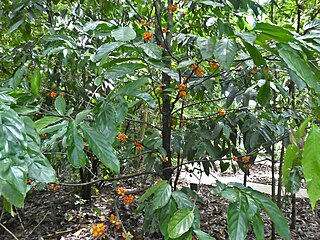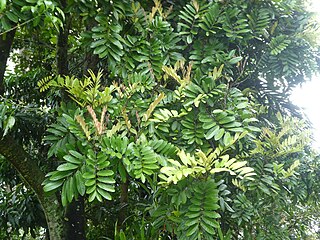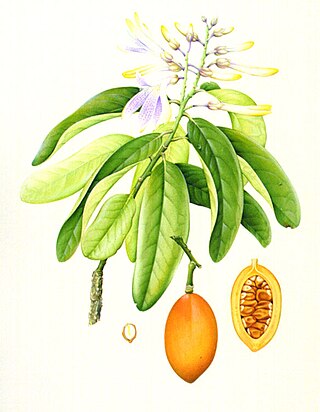
Athertonia is a monotypic genus of plants in the family Proteaceae. The sole described species is Athertonia diversifolia, commonly known as Atherton oak, athertonia, creamy silky oak or white oak. It is endemic to a small part of the Wet Tropics of Queensland, Australia. A relative of the macadamia, it has potential in horticulture and the bushfood industry.

Normanbya is a monotypic genus of palms containing the single species Normanbya normanbyi, which is known by the common name black palm It is endemic to Queensland, Australia and is threatened by habitat destruction.

Gardenia actinocarpa is a rare and endangered plant in the coffee and gardenia family Rubiaceae, native to a very restricted area within the Wet Tropics rainforest of northeastern Queensland.

Pseuduvaria froggattii is a rare species of tree which is restricted to a very small part of northeastern Queensland, Australia. It is a member of the custard apple and soursop family Annonaceae, and was first described in 1887. Despite the small range its status considered to be least concern.

Argophyllum palumense is a plant in the Argophyllaceae family endemic to a small part of north eastern Queensland. It was described and named in 2018.

Mackinlaya macrosciadea, commonly known as mackinlaya or blue umbrella, is a plant in the carrot, fennel and parsley family Apiaceae, found in the Northern Territory and Queensland, Australia.

Diploglottis harpullioides, commonly known as Babinda tamarind, is a rainforest tree in the lychee and maple family Sapindaceae which is found only in northeast Queensland, Australia.

Diploglottis obovata, commonly known as blunt-leaved tamarind, is a plant in the family Sapindaceae endemic to central eastern Queensland, Australia. Until 1987 it was considered to be a form of the very closely related Diploglottis diphyllostegia.

Gillbeea adenopetala, commonly known as Pink alder, is an evergreen tree in the largely southern hemisphere family Cunoniaceae. It was first described in 1865 and is endemic to a small part of Queensland, Australia.

Diploglottis bernieana, commonly known as Bernie's tamarind or large leaf tamarind, is a plant in the maple and lychee family Sapindaceae. It was first described in 1987 by the Australian botanist Sally T. Reynolds and is found only the Wet Tropics region of northeastern Queensland, Australia.

Diploglottis alaticarpa is a plant in the maple and lychee family Sapindaceae which is endemic to northeast Queensland, Australia. It was first recognised as a distinct species in 1994 and was formally described in 2014.

Actephila foetida is a plant in the family Phyllanthaceae that is found only in a very restricted range within the Wet Tropics bioregion of Queensland, Australia. It was first described in 1927.

Peperomia bellendenkerensis is a plant in the pepper family Piperaceae found only in the Wet Tropics bioregion of Queensland, Australia.

Peperomia hunteriana is a plant in the pepper family Piperaceae found only in the Wet Tropics bioregion of Queensland, Australia.

Xanthophyllum fragrans, commonly known as fragrant boxwood, is an evergreen plant in the family Polygalaceae found only in the Wet Tropics bioregion of Queensland, Australia.

Lepiderema sericolignis, commonly known as silkwood, is a plant in the maple and lychee family Sapindaceae found only in the Wet Tropics bioregion of Queensland, Australia.

Larsenaikia ochreata, commonly known as Wenlock gardenia, scented Gardenia bush or wild Gardenia, is a plant in the coffee family Rubiaceae endemic to Queensland, Australia.

Diploglottis smithii, commonly known as Smith's tamarind or wild tamarind, is a plant in the maple family Sapindaceae found only in the Wet Tropics bioregion of Queensland, Australia.
Cryptocarya cercophylla is a species of flowering plant in the laurel family and is endemism to Wooroonooran National Park in north Queensland. It is a poorly-formed tree with egg-shaped to elliptic leaves, the flowers creamy-green or cream-coloured and tube-shaped, and the fruit an elliptic, red to shiny black drupe.
Thismia hawkesii, commonly known as fairy lantern, is a plant in the family Burmanniaceae found only in the Wet Tropics bioregion of Queensland, Australia.

















